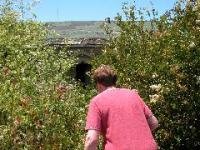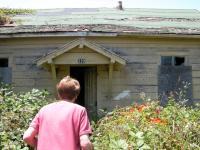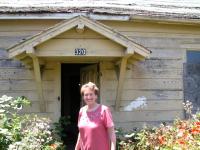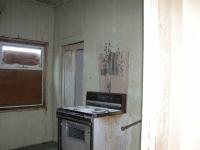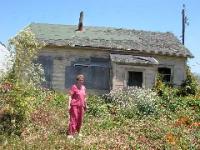In an earlier post, Ernie Alves (“Our Cows are Outstanding in Their Field”) hinted at the devastating effect of WWII on Coastsiders–especially Germans and Italians without citizenship papers–who were prohibited after the Japanese attack on Pearl Harbor from living or working on the west side of Main Street, the Highway 1 of that era.
What was on the west side of Main Street? The beaches, the stores, the school and the restaurant, the economic and social life’s blood of the town. Fear of another attack by the Japanese was so great that the military patrolled the beaches, built bunkers and placed gun emplacements on the hillsides.
I’d heard Germans and Italians were not permitted to cross the freshly painted white line down the center of Main Street, yet I didn’t meet anyone who would provide details until a couple of years ago when, through a phone tip, I interviewed Josephine Revheim. A Pacifica resident, Josephine had clearly suffered as a young woman but she had grown into a confident, articulate person who had done very well with her life.
At 15, Jo was the only daughter of Half Moon Bay farmer Antonio Giurliani and his wife, Marianna. The close-knit family resided in a little house next door to the old Catholic Church that stood west of Half Moon Bay’s Main Street. On the land adjacent to their home they grew sprouts and chokes.
The Giurliani’s came from Lucca, Italy, Jo’s father’s home, but her mom was actually born in Marseille, France. Still, everybody in Half Moon Bay considered them all Italian.
Soon after Pearl Harbor on December 7, 1941 army trucks rolled into Half Moon Bay, and, Jo told me, her father, who didn’t have citizenship papers, received an official letter from the US government ordering the family to move to the east side of Main Street. They had two weeks to comply.
Jo recalled seeing the printed notices on telephone poles throughout the town ordering all “aliens, Germans, Italians and Japanese” to relocate. The Japanese were rounded up and detained at Tanforan Racetrack. That history is well documented but in Half Moon Bay there was no central location for Germans and Italians. After registering as aliens in San Mateo they had to leave their homes on the west side.
(Technically, Josephine and her mom could have stayed on the farm but she asks: “How could we maintain a large farm without dad’s help?” The family decided to stick it out together.)
There were plenty of homes on the east side but unless you had a relative to help you were out of luck. That was the situation Jo and her family found themselves in–no place to move to and time was running out fast.
“Luckily,” Josephine said, “dad had a friend with a ranch in Higgins Canyon, south of town. He not only hired dad, he gave our family a place to live in the Johnston House. In those days it wasn’t called the Johnston House–we called it ‘the old house on the hill'”.
(Built in the 1850s by pioneer James Johnston, the fully restored Johnston House has become a famous landmark that stands on a hill at the south end of Main Street).
Josephine still recalls the morning her family moved into “the old house on the hill”. She says, “It hit us, what we were in for. The rat-infested house had no windows and vagrants had slept there, leaving behind garbage. Straw covered the dirt floors, the outhouse was halfway up the hill in the back, and when it rained it was like a waterfall, but there was plenty of room, and thank God there was cold running water to drink.”
Most important, the house was located on the east side of Main Street. But the school and the stores were on the west side. If they crossed the white line, they would be breaking the law. To check on their farm they’d have to do it secretly, because, if caught, it was likely someone would inform on them.
The most humiliating part of the whole experience for then 15-year-old Josephine were the stares and unfriendliness she and her familly encountered. One of the worst recollections was of her mother fighting off an assualt by some angry, unthinking local. It’s not hard to understand that many of her remembrances are so unpleasant that she remains uncomfortable talking about them today.
After about five months the Giurlani’s nightmare ended.
“We came home,” Jo says, “and at least the house and barn were still there. Everything else was gone, the crops were gone, and even our wild pigeons that had nested in the barn were gone.”
Not long after they settled back in their home the family received a letter from the US government advising them to become citizens or face deportation. They all got their citizenship papers.
Shortly after my interview with Josephine Revheim, we took a ride to Half Moon Bay to see the house she had lived in as a 15-year-old before her family was ordered to move out of it. Surprisingly the house was still standing, but it was vacant and uncared for, with broken glass on the floor, grafitti on the walls, empty paper coffee cups, somebody’s crashpad, and, right there, in the middle of town.
Why was this house still standing? Some connection to the story I’ve told?
Of course, I haven’t been back and don’t know if the house still stands but here are the photos I took a couple of years ago. That’s Josephine Revheim in all the pictures.

